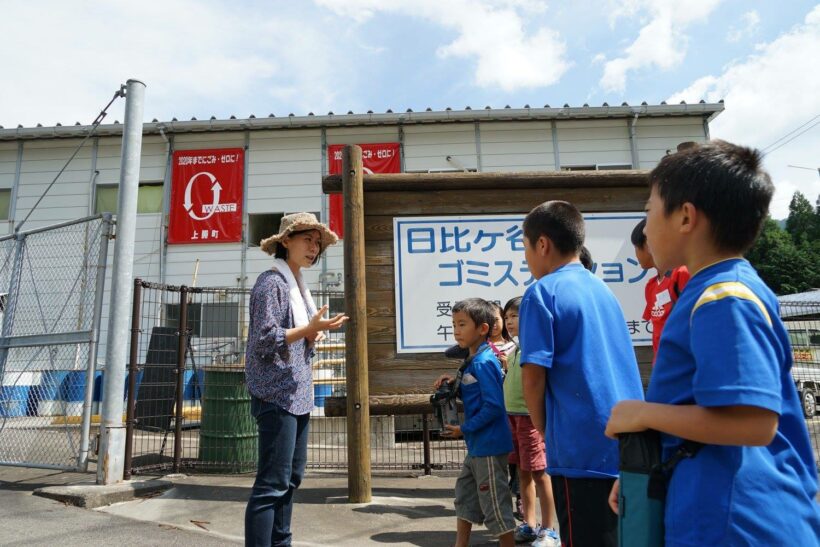Akira Sakano: Contextualizing Zero Waste
by Marco Sumayao

On quiet days when she isn’t busy championing Zero Waste policies in Japan, you might find Akira Sakano on a secluded mountaintop, on the lookout for rare birds. She’s had a lifelong fascination with the creatures, and these small trips to see them help her reconnect with nature, as well as with herself. They were one of the first reasons why she started caring about the environment. After she’d learned at an early age that the Kakapo, the world’s biggest flightless parrot, was an endangered species, she became aware of the need for conservation efforts.
When it comes to her environmental work, however, it’s all about the people.
Akira is the founder of Zero Waste Japan and a former Chair on the Board of Directors of Zero Waste Academy. Through Zero Waste Japan, Akira and her team help local governments and businesses develop Zero Waste policies within their respective areas of responsibility. Instead of recommending “one size fits all” solutions, they specialize in crafting policies tailored to each of their partner communities’ unique personalities. Their grassroots projects are then treated as case studies that other communities can model themselves after, and in which policy-makers can find inspiration.
It’s an approach she learned during her time with Zero Waste Academy, where she spent five years helping the small town of Kamikatsu establish itself as Japan’s first Zero Waste municipality.
Kamikatsu is a remote mountain town, and its location presents several issues when it comes to waste management. Incineration can’t be done without going beyond emission limitations while transporting trash to better-equipped towns is both inefficient and costly. Pursuing a Zero Waste policy was Kamikatsu’s most logical course of action, and so the local government declared its ambition to go Zero Waste in 2003. By the time Akira arrived in 2015, however, the town’s progress in this effort had plateaued.
“Kamikatsu was already very good at waste segregation and recycling, and then they started implementing reusing and trying to circulate things within the community. But the amount of waste produced hasn’t changed. They were in the stage of feeling a bit stuck in their Zero Waste activities,” she shared.
“How can we go beyond that? Generally, people achieve maybe 70% [waste reduction], but if you think about Zero Waste, then we might be able to achieve 90%. That’s the kind of mentality that I see in the concept of Zero Waste, so ‘How can we actually create that mentality into reality?,’ was the very key question,” she added.
Based on her experience, Akira estimates that only 10% of a community’s population starts out very engaged in sustainability. Another 10% is either against the idea or find it a bother. What Akira learned, however, is that reaching out to the 80% of people who are generally ambivalent about the matter can do wonders. In order to do that, one needs to feel the pulse of the community.
“It’s more about how we can create the right followership within the community,” she said. “When we only speak about the environment and say ‘this is important,’ it doesn’t reach them. In the case of Kamikatsu, at least, community engagement is a totally different topic from Zero Waste or environmental engagement.”
“People have more motivation or ownership in contributing to their own community or contributing to their own daily life baselines. That’s why we shifted towards engaging them with the topic of ‘What does it mean to actually do segregation in your daily life?’”
Communicating the importance of Zero Waste was only half the equation in Kamikatsu. In order to reach their goals, Akira and her team needed to help them contextualize the value of Zero Waste policies on a personal level.
For Kamikatsu, that meant showing residents the direct economic benefits of waste segregation. At the town’s segregation centers, each sign that labels a segregation bin also shows you how much money the local government saves for each waste item you sort properly. In the case of recyclables and reusables, the signs also tell you where they go and what each item will become.
Seeing things like the monetary value of recycled aluminum can, for example, ended up having a surprisingly profound effect on the townsfolks’ motivation. Their recycling rate jumped up to 81%, even with an astonishing 45 different waste segregation categories for them to sort their trash into. The main waste collection center became a place for gatherings, where the elderly could connect with each other over their daily routines. Zero Waste wasn’t just a lofty goal anymore; it was a collaborative social effort in uplifting their town.
Kamikatsu quickly became one of the Zero Waste movement’s most inspiring stories. International news agencies traveled to Japan to find out how a small mountain town was able to achieve such startling results. And for Akira, all this newfound attention presented a world of opportunities.
“Doing something very special, and then having it as a star in the dark sky is important, which was kind of what Kamikatsu was trying to do. It was a star [that inspired] others to say, ‘We can actually do this, you know?’ Akira said.
“But that wasn’t enough to actually get everyone to start doing things,” she continued. “That’s why I thought, okay, my challenge definitely is to first actually create more case studies and they say, ‘Hey, you know, everyone could do it.’ The more I have these successful cause elements in general, the more people could actually see that. The entire Zero Waste concept is the same, but of course, the approaches might be different in different communities and locations.”
Akira learned that people were more willing to adopt Zero Waste policies if they felt they were customized to their communities’ needs. It was more important to have multiple case studies with practices people felt they could copy, rather than a single study that prescribed a solution they couldn’t imagine working for them.
Akira founded Zero Waste Japan to help develop more of these case studies. The idea was that, if more and more towns could be living proof that Zero Waste is both feasible and effective, the different lessons learned from these towns could impact policy on a national scale. And her efforts don’t just stop there; Akira is currently working on a multi-pronged approach to realizing Zero Waste Japan’s goals. And as with Kamikatsu, it starts with people.
“There are two things I’m doing right now,” she shared. “One is to develop people who can take my role in different communities. That’s what I’m doing with our current new organization called Green innovation. We are running Green Innovator Academy as a four-to-six-month program to educate young professionals and students, to go through all this basic knowledge, actually letting them experience how to craft policy, how to craft business models. Then they can be trained afterward to be sent to rural communities in certain locations. They can be the leading person to bridge with someone supporting from outside, and to actually start moving things in the local ground.”
“At the same time, I’m also creating a platform for different organizations to pitch the results or successes or outcomes we already have, to be built up as clear numbers of the impact [of Zero Waste policies]. We’re now engaging small and larger groups in various locations here in Japan who are doing organic waste diversion from incineration. We are collecting all the data. In fact, we can actually talk to national government policy-makers on how we can hasten the impact of the diversion of organic waste,” she said.
All these efforts, Akira said, are meant to contribute towards a long-term movement for Zero Waste in Japan. She understands that policy changes take years, even decades, to be established and that Zero Waste Japan’s goals may not even be realized within her lifetime. By building up people who can push the movement forward alongside her, the number of communities adopting Zero Waste policies can grow exponentially, becoming more stars to inspire others. Together, she believes that they can build the foundations of a truly Zero Waste future for their country.
In that future, perhaps, Japan’s birds will be flying in cleaner, starlit skies.






